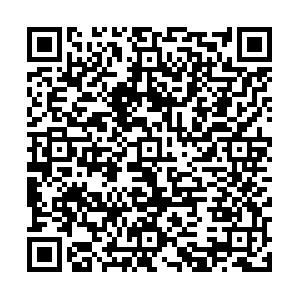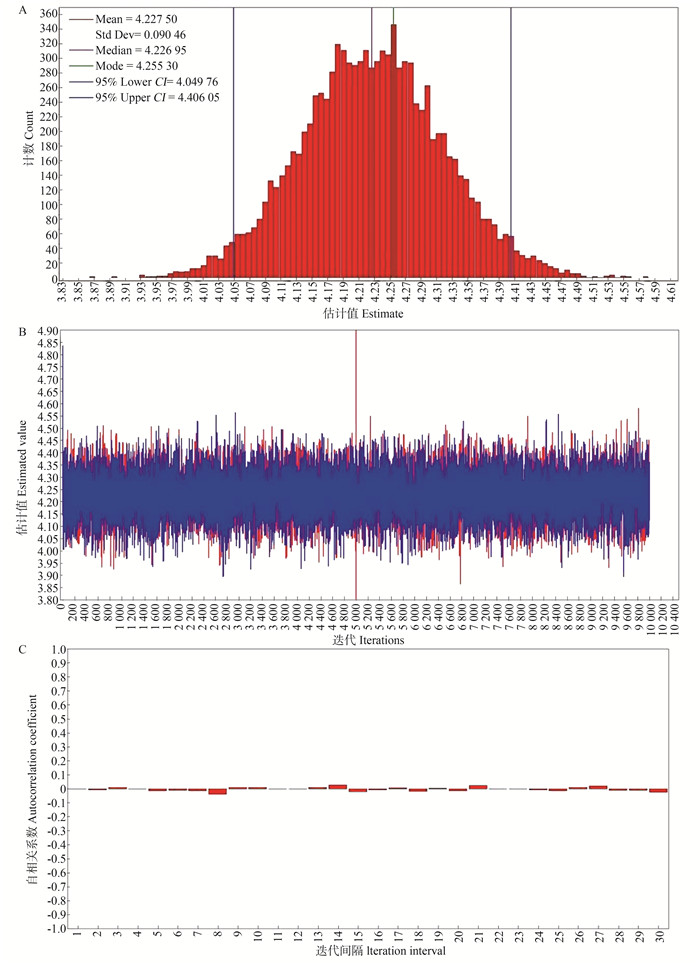A comparative analysis of comparison of latent variables, manifest variables and Bayesian mediation effect models
-
摘要:
目的 比较潜变量、显变量和贝叶斯中介效应模型的中介效应及模型拟合优劣。 方法 数据来源于一项关于大学生行为与健康的专项调查。6种饮料消费评分为自变量,匹兹堡睡眠质量指数量表 7个维度评分为中介变量,9项患者健康问卷评估抑郁症状评分为因变量。分别使用潜变量、显变量和贝叶斯中介效应模型分析睡眠质量在饮料消费与抑郁症状关联中的中介效应。 结果 3种模型的中介效应值分别为0.12、0.06和0.06,中介效应分别占总效应的71%、43%和43%,中介效应与直接效应之比分别为2.49、0.76和0.76。显变量中介效应模型和贝叶斯中介效应模型的中介效应几乎一致,而潜变量中介效应模型的中介效应估计值、中介效应与总效应之比和中介效应与直接效应之比分别是前2种模型的2.00倍、1.65倍和3.27倍。 结论 3种模型均显示存在中介效应,潜变量中介效应模型估计的中介效应值更高,贝叶斯中介效应模型拟合评价指标更丰富。 Abstract:Objective The study aimed to compare the mediating effects and model fitting of the latent variable, the manifest variable and the Bayesian mediating effect model. Methods Data from a previous specialized survey on college students′ behavior and health were utilized. Six beverage consumption scores served as independent variables, seven dimensions of the Pittsburgh Sleep Quality Index Scale were mediating variables, and nine patient health questionnaire assessment depressive symptom scores were dependent variables. The mediating effects of sleep quality on the association between beverage consumption and depressive symptoms were analyzed using latent variable, manifest variable, and Bayesian mediation effect models. Results The mediating effect values of the above three models were 0.12, 0.06, and 0.06, respectively. The mediating effect accounted for 71%, 43%, and 43% of the total effect, and the ratio of the mediating effect to the direct effect were 2.49, 0.76, and 0.76, respectively. The mediating effects of the manifest variable mediation effect model and the Bayesian mediation effect model were nearly identical. The estimated value of the mediating effect, the ratio of the mediating effect to the total effect, and the ratio of the mediating effect to the direct effect of the latent variable mediation effect model were 2.00 times, 1.65 times, and 3.27 times those of the other two models, respectively. Conclusions While the mediating effects of the three models were consistent, the latent variable mediation effect model estimated a higher mediating effect value, and the Bayesian mediation effect model provided a more comprehensive evaluation index for model fitting. -
Key words:
- Mediating effect /
- Structural equation model /
- Manifest variable /
- Latent variable /
- Bayesian
-
图 3 三种中介效应模型中介效应分析
1. A: 潜变量中介效应模型; 2. B: 显变量中介效应模型; 3. C: 贝叶斯中介效应模型; 4. a: 总效应; 5. b: 中介效应与总效应之比; 6. c: 中介效应与直接效应之比。
Figure 3. Analysis of the mediation effect of three mediation effect models
1. A: latent variable mediation effect model; 2. B: manifest variable mediation effect model; 3. C: Bayesian mediation effect model; 4. a: total effect; 5. b: the ratio of the mediating effect to the total effect; 6. c: the ratio of mediating effects to direct effects.
图 4 贝叶斯中介效应模型拟合评价
1. A: 潜变量中介效应模型; 2. B: 显变量中介效应模型; 3. C: 贝叶斯中介效应模型; 4. x: 饮料消费; 5. m: 睡眠质量; 6. y: 抑郁症状。
Figure 4. Evaluation of the fit of the Bayesian mediation effect model
1. A: latent variable mediation effect model; 2. B: manifest variable mediation effect model; 3. C: Bayesian mediation effect model; 4. x: beverage consumption; 5. m: sleep quality; 6. y: depressive symptoms.
表 1 变量赋值及基本情况
Table 1. Variable assignment and basic information
模型Model AIC BIC 样本量调整BIC
Sample-size adjusted BIC模型拟合χ2检验χ2值
Chi-Square test of model fit Chi-Square value模型拟合χ2检验P值
Chi-Square test of model fit P valueRMSEA 潜变量中介效应模型
Latent variable mediating effect model223 988.90 224 458.95 224 226.98 3 829.27 0.00 0.06 显变量中介效应模型
Manifest variable mediating effect model49 402.42 49 447.49 49 425.25 0.00 0.00 0.00 贝叶斯中介效应模型
Bayesian mediating effect model― 49 447.50 ― ― ― ― 模型Model CFI TLI SRMR 贝叶斯后验预测检验χ2值
Bayesian posterior predictive phecking using Chi-SquareDIC 估计参数数量(pD)
Estimated Number of Parameters (pD)潜变量中介效应模型
Latent variable mediating effect model0.92 0.90 0.05 ― ― ― 显变量中介效应模型
Manifest variable mediating effect model1.00 1.00 0.00 ― ― ― 贝叶斯中介效应模型
Bayesian mediating effect model― ― ― 0.51 49 402.58 7.08 注:1. “―”表示模型未提供数据。
2. AIC, 赤池信息准则; BIC, 贝叶斯信息准则; RMSEA, 近似误差均方根; CFI, 比较拟合指数; TLI, Tucker-Lewis指数; SRMR, 标准化残差均方和平方根; DIC, 偏差信息准则。
Note: 1. "―" indicates that the model did not provide data.
2. AIC, Akaike information criterion; BIC, Bayesian information criterion; RMSEA, root-mean-square error of approximation; CFI, comparative fit index; TLI, Tucker-Lewis index; SRMR, standardized root mean square residual; DIC, deviance information criterion.表 2 3种模型中介效应估计值
Table 2. Estimates of the mediation effect of the three models
模型Model 效应
Effect路径Path 95% CI 效应值
Effect valueSE/SD ① t值
valueP值
value潜变量中介效应模型
Latent variable mediating effect model直接效应
Direct effect饮料消费→抑郁症状
Beverage consumption→Depressive symptoms0.02~0.08 0.05 0.02 2.88 0.004 睡眠质量→抑郁症状
Sleep quality→Depressive symptoms0.73~0.78 0.76 0.02 50.30 < 0.001 饮料消费→睡眠质量
Beverage consumption→Sleep quality0.11~0.21 0.16 0.03 6.01 < 0.001 中介效应
Mediating effect饮料消费→睡眠质量→抑郁症状
Beverage consumption→Sleep quality→Depressive symptoms0.08~0.16 0.12 0.02 5.91 < 0.001 显变量中介效应模型
Manifest variable mediating effect model直接效应
Direct effect饮料消费→抑郁症状
Beverage consumption→Depressive symptoms0.05~0.11 0.08 0.02 5.32 < 0.001 睡眠质量→抑郁症状
Sleep quality→Depressive symptoms0.54~0.59 0.56 0.01 44.46 < 0.001 饮料消费→睡眠质量
Beverage consumption→Sleep quality0.08~0.15 0.11 0.02 6.27 < 0.001 中介效应
Mediating effect饮料消费→睡眠质量→抑郁症状
Beverage consumption→Sleep quality→Depressive symptoms0.04~0.08 0.06 0.01 6.24 < 0.001 贝叶斯中介效应模型
Bayesian mediating effect model直接效应
Direct effect饮料消费→抑郁症状
Beverage consumption→Depressive symptoms0.06~0.11 0.01 — 0.08 < 0.001 睡眠质量→抑郁症状
Sleep quality→Depressive symptoms0.54~0.58 0.56 0.01 — < 0.001 饮料消费→睡眠质量
Beverage consumption→Sleep quality0.08~0.14 0.11 0.01 — < 0.001 中介效应
Mediating effect饮料消费→睡眠质量→抑郁症状
Beverage consumption→Sleep quality→Depressive symptoms0.05~0.08 0.06 0.01 — < 0.001 注:“—”表示模型未提供数据。
①潜变量中介效应模型和显变量中介效应模型提供SE,贝叶斯中介效应模型提供SD。
Note: "—"indicates that the model did not provide data.
① The latent variable mediation effect model and the manifest variable mediation effect model provide SE, and the Bayesian mediation effect model provides SD. -
[1] Wang YB, Chen Z, Goldstein JM, et al. A Bayesian regularized mediation analysis with multiple exposures[J]. Stat Med, 2019, 38(5): 828-843. DOI: 10.1002/sim.8020. [2] 温忠麟, 叶宝娟. 中介效应分析: 方法和模型发展[J]. 心理科学进展, 2014, 22(5): 731-745. DOI: 10.3724/SP.J.1042.2014.00731.Wen ZL, Ye BJ. Analyses of mediating effects: the development of methods and models[J]. Adv Psychol Sci, 2014, 22(5): 731-745. DOI: 10.3724/SP.J.1042.2014.00731. [3] 温忠麟, 张雷, 侯杰泰, 等. 中介效应检验程序及其应用[J]. 心理学报, 2004, 36(5): 614-620. DOI: 10.3969/j.issn.1671-6981.2003.01.021.Wen ZL, Zhang L, Hou JT, et al. Testing and application of the mediating effects[J]. Acta Psychol Sin, 2004, 36(5): 614-620. DOI: 10.3969/j.issn.1671-6981.2003.01.021. [4] Henderson KA, Obeid N, Buchholz A, et al. Coping in adolescents: a mediator between stress and disordered eating[J]. Eat Behav, 2022, 47: 101626. DOI: 10.1016/j.eatbeh.2022.101626. [5] Xu H, Guo J, Wan Y, et al. Association between screen time, fast foods, sugar-sweetened beverages and depressive symptoms in Chinese adolescents[J]. Front Psychiatry, 2020, 11: 458. DOI: 10.3389/fpsyt.2020.00458. [6] Rijnhart JJM, Twisk JWR, Chinapaw MJM, et al. Comparison of methods for the analysis of relatively simple mediation models[J]. Contemp Clin Trials Commun, 2017, 7: 130-135. DOI: 10.1016/j.conctc.2017.06.005. [7] VanderWeele TJ, Tchetgen Tchetgen EJ. Mediation analysis with time varying exposures and mediators[J]. J R Stat Soc Series B Stat Methodol, 2017, 79(3): 917-938. DOI: 10.1111/rssb.12194. [8] Lee H, Herbert RD, McAuley JH. Mediation Analysis[J]. JAMA, 2019, 321(7): 697-698. DOI: 10.1001/jama.2018.21973. [9] 方杰, 温忠麟, 张敏强, 等. 基于结构方程模型的多层中介效应分析[J]. 心理科学进展, 2014, 22(3): 530-539. DOI: 10.3724/SP.J.1042.2014.00530.Fang J, Wen ZL, Zhang MQ, et al. Analyzing multilevel mediation using multilevel structural equation models[J]. Adv Psychol Sci, 2014, 22(3): 530-539. DOI: 10.3724/SP.J.1042.2014.00530. [10] Stamps JA, Frankenhuis WE. Bayesian models of development[J]. Trends Ecol Evol, 2016, 31(4): 260-268. DOI: 10.1016/j.tree.2016.01.012. [11] Sint K, Rosenheck R, Lin H. Latent class mediator for multiple indicators of mediation[J]. Stat Med, 2021, 40(12): 2800-2820. DOI: 10.1002/sim.8929. [12] 方杰, 温忠麟. 三类多层中介效应分析方法比较[J]. 心理科学, 2018, 41(4): 962-967. DOI: 10.16719/j.cnki.1671-6981.20180430.Fang J, Wen ZL. A comparison of three methods for testing multilevel mediation[J]. J Psychol Sci, 2018, 41(4): 962-967. DOI: 10.16719/j.cnki.1671-6981.20180430. [13] Rijnhart JJM, Lamp SJ, Valente MJ, et al. Mediation analysis methods used in observational research: a scoping review and recommendations[J]. BMC Med Res Methodol, 2021, 21(1): 226. DOI: 10.1186/s12874-021-01426-3. [14] 侯杰泰, 温忠麟, 成子娟. 结构方程模型及其应用[M]. 北京: 教育科学出版社, 2004: 32-38.Hou JT, Wen ZL, Cheng ZJ. Structural equation model and its application[M]. Beijing: Education Science Press, 2004: 32-38. [15] 徐洪吕, 伍晓艳, 陶舒曼, 等. 大学生饮料消费睡眠质量和抑郁症状的关系[J]. 中国学校卫生, 2020, 41(1): 16-20. DOI: 10.16835/j.cnki.1000-9817.2020.01.005.Xu HL, Wu XY, Tao SM, et al. Beverages consumption, sleep quality and depressive symptoms in Chinese university students: a latent variable mediation model[J]. Chin J Sch Health, 2020, 41(1): 16-20. DOI: 10.16835/j.cnki.1000-9817.2020.01.005. [16] Vrublevska J, Trapencieris M, Rancans E. Adaptation and validation of the Patient Health Questionnaire-9 to evaluate major depression in a primary care sample in Latvia[J]. Nord J Psychiatry, 2018, 72(2): 112-118. DOI: 10.1080/08039488.2017.1397191. [17] Ju M, Tao Y, Lu Y, et al. Evaluation of sleep quality in adolescent patients with osteosarcoma using Pittsburgh Sleep Quality Index[J]. Eur J Cancer Care (Engl), 2019, 28(4): e13065. DOI: 10.1111/ecc.13065. [18] Du Y, Du J, Liu X, et al. Multiple-to-multiple path analysis model[J]. PLoS One, 2021, 16(3): e0247722. DOI: 10.1371/journal.pone.0247722. [19] 方绮雯, 刘振球, 袁黄波, 等. 结构方程模型的构建及AMOS软件实现[J]. 中国卫生统计, 2018, 35(6): 958-960. https://www.cnki.com.cn/Article/CJFDTOTAL-ZGWT201806045.htmFang QW, Liu ZQ, Yuan HB, et al. Construction of structural equation model and realization of AMOS software[J]. Chin J Health Statistics, 2018, 35(6): 958-960. https://www.cnki.com.cn/Article/CJFDTOTAL-ZGWT201806045.htm [20] 侯杰泰, 温忠麟, 成子娟. 结构方程模型及其应用[M]. 北京: 教育科学出版社, 2004: 43-48.Hou JT, Wen ZL, Cheng ZJ. Structural equation model and its application[M]. Beijing: Education Science Press, 2004: 43-48. [21] 王卫东. 结构方程模型原理与应用[M]. 北京: 中国人民大学出版社, 2010: 17-24.Wang WD. Principles and applications of structural equation models[M]. Beijing: Renmin University of China Press, 2010: 17-24. [22] 王孟成. 潜变量建模与Mplus的应用(基础篇)[M]. 重庆: 重庆大学出版社, 2014: 205-207.Wang MC. Latent variable modeling and the application of mplus (the basics)[M]. Chongqing: Chongqing University Press, 2014: 205-207. [23] 王孟成. 潜变量建模与Mplus的应用(进阶篇)[M]. 重庆: 重庆大学出版社, 2018: 291-293.Wang MC. Latent variable modeling and the application of Mplus (advanced)[M]. Chongqing: Chongqing University Press, 2018: 291-293. [24] Rindskopf D. Overview of Bayesian statistics[J]. Eval Rev, 2020, 44(4): 225-237. DOI: 10.1177/0193841X19895623. [25] Miočević M, MacKinnon DP, Levy R. Power in Bayesian mediation analysis for small sample research[J]. Struct Equ Modeling. 2017, 24(5): 666-683. DOI: 10.1080/10705511.2017.1312407. [26] Miočević M, Golchi S. Bayesian mediation analysis with power prior distributions[J]. Multivariate Behav Res, 2022, 57(6): 978-993. DOI: 10.1080/00273171.2021.1935202. [27] Baron RM, Kenny DA. The moderator-mediator variable distinction in social psychological research: conceptual, strategic, and statistical considerations[J]. J Pers Soc Psychol, 1986, 51(6): 1173-1182. DOI: 10.1037//0022-3514.51.6.1173. [28] Zhao X, Lynch JG, Chen Q. Reconsidering baron and Kenny: myths and truths about mediation analysis[J]. J Consum Res, 2010, 37(2): 197-206. DOI: 10.1086/651257. [29] Enders CK, Fairchild AJ, Mackinnon DP. A Bayesian approach for estimating mediation effects with missing data[J]. Multivariate Behav Res, 2013, 48(3): 340-369. DOI: 10.1080/00273171.2013.784862. [30] Williams J, Mackinnon DP. Resampling and distribution of the product methods for testing indirect effects in complex models[J]. Struct Equ Modeling, 2008, 15(1): 23-51. DOI: 10.1080/10705510701758166. [31] Mackinnon DP, Lockwood CM, Williams J. Confidence limits for the indirect effect: distribution of the product and resampling methods[J]. Multivariate Behav Res, 2004, 39(1): 99. DOI: 10.1207/s15327906mbr3901_4. [32] 方杰, 张敏强. 中介效应的点估计和区间估计: 乘积分布法、非参数Bootstrap和MCMC法[J]. 心理学报, 2012, 44(10): 1408-1420. DOI: 10.3724/SP.J.1041.2012.01408.Fang J, Zhang MQ. Assessing point and interval estimation for the mediating effect: distribution of the product, nonparametric Bootstrap and Markov chain Monte Carlo Methods[J]. Acta Psychol Sin, 2012, 44(10): 1408-1420. DOI: 10.3724/SP.J.1041.2012.01408. [33] Lefebvre G, Samoilenko M, Boucoiran I, et al. A Bayesian finite mixture of bivariate regression model for causal mediation analyses[J]. Stat Med, 2018, 37(25): 3637-3660. DOI: 10.1002/sim.7835. [34] Huang J, Yuan Y. Bayesian dynamic mediation analysis[J]. Psychol Methods, 2017, 22(4): 667-686. DOI: 10.1037/met0000073. [35] Miocevic M, Mackinnon DP, Levy R. Power in Bayesian mediation analysis for small sample research[J]. Struct Equ Modeling, 2017, 24(5): 666-683. DOI: 10.1080/10705511.2017.1312407. [36] Sakai H, Murakami K, Kobayashi S, et al. Food-based diet quality score in relation to depressive symptoms in young and middle-aged Japanese women[J]. Br J Nutr, 2017, 117(12): 1674-1681. DOI: 10.1017/S0007114517001581. [37] Roberts RE, Duong HT. The prospective association between sleep deprivation and depression among adolescents[J]. Sleep, 2014, 37(2): 239-244. DOI: 10.5665/sleep.3388. [38] Rindskopf D. Reporting Bayesian results[J]. Eval Rev, 2020, 44(4): 354-375. DOI: 10.1177/0193841X20977619. [39] 陶秋山, 詹思延, 李立明. 流行病学研究中的病因与病因推断[J]. 中华流行病学杂志, 2004, 25(11): 86-89. DOI: 10.3760/j.issn:0254-6450.2004.11.021.Tao QS, Zhan SY, Li LM. Etiology and etiological inference in epidemiological research[J]. Chin J Epidemiol, 2004, 25(11): 86-89. DOI: 10.3760/j.issn:0254-6450.2004.11.021. -





 下载:
下载:




